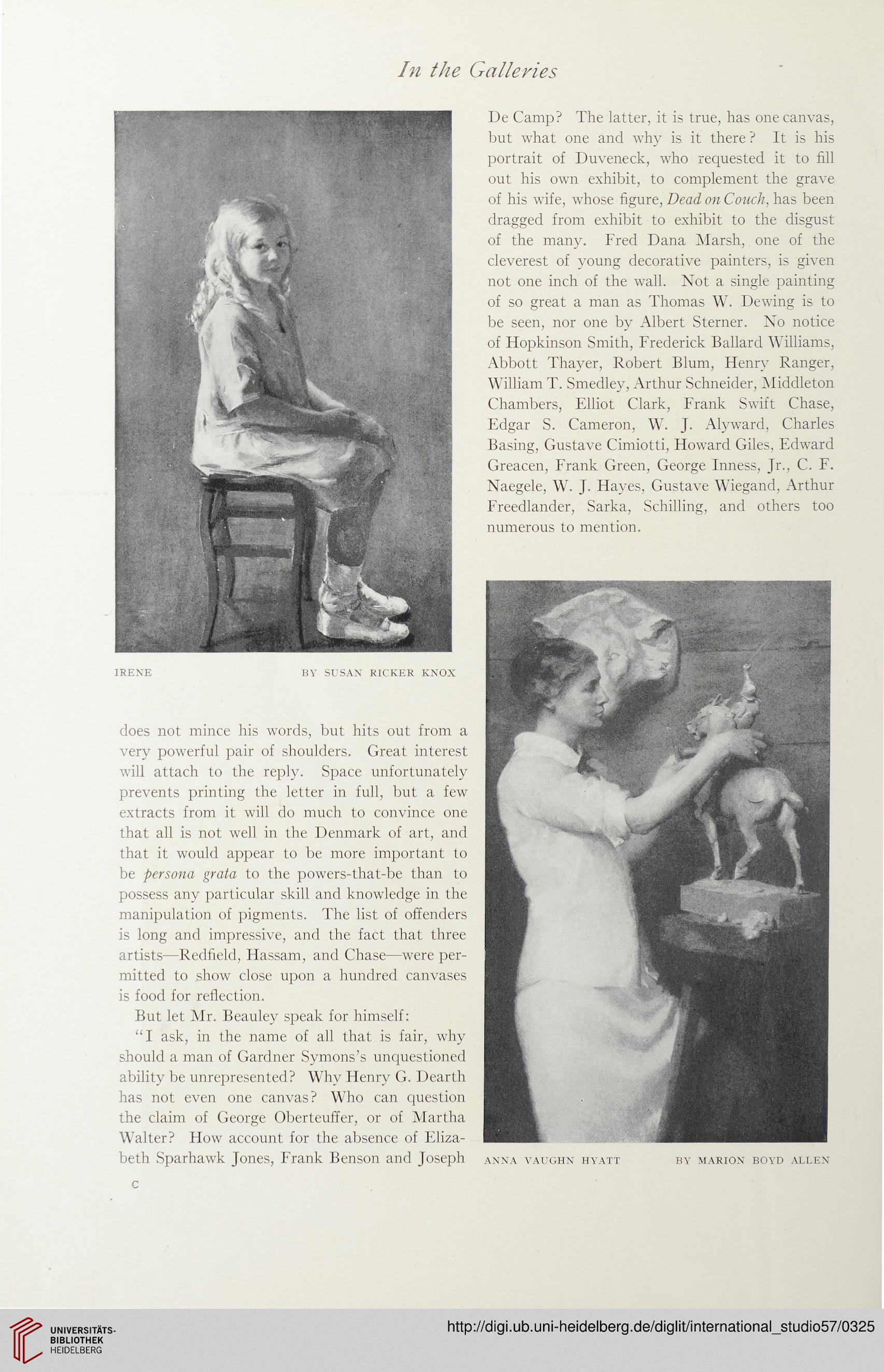In the Galleries
IRENE
BY SUSAN RICKER KNOX
does not mince his words, but hits out from a
very powerful pair of shoulders. Great interest
will attach to the reply. Space unfortunately
prevents printing the letter in full, but a few
extracts from it will do much to convince one
that all is not well in the Denmark of art, and
that it would appear to be more important to
be persona grata to the powers-that-be than to
possess any particular skill and knowledge in the
manipulation of pigments. The list of offenders
is long and impressive, and the fact that three
artists—Redfield, Hassam, and Chase—were per-
mitted to show close upon a hundred canvases
is food for reflection.
But let Mr. Beauley speak for himself:
“I ask, in the name of all that is fair, why
should a man of Gardner Symons’s unquestioned
ability be unrepresented? Why Henry G. Dearth
has not even one canvas? Who can question
the claim of George Oberteuffer, or of Martha
Walter? How account for the absence of Eliza-
beth Sparhawk Jones, Frank Benson and Joseph
De Camp? The latter, it is true, has one canvas,
but what one and why is it there? It is his
portrait of Duveneck, who requested it to fill
out his own exhibit, to complement the grave
of his wife, whose figure, Dead, on Couch, has been
dragged from exhibit to exhibit to the disgust
of the many. Fred Dana Marsh, one of the
cleverest of young decorative painters, is given
not one inch of the wall. Not a single painting
of so great a man as Thomas W. Dewing is to
be seen, nor one by Albert Sterner. No notice
of Hopkinson Smith, Frederick Ballard Williams,
Abbott Thayer, Robert Blum, Henry Ranger,
William T. Smedley, Arthur Schneider, Middleton
Chambers, Elliot Clark, Frank Swift Chase,
Edgar S. Cameron, W. J. Alyward, Charles
Basing, Gustave Cimiotti, Howard Giles, Edward
Greacen, Frank Green, George Inness, Jr., C. F.
Naegele, W. J. Hayes, Gustave Wiegand, Arthur
Freedlander, Sarka, Schilling, and others too
numerous to mention.
ANNA VAUGHN HYATT BY MARION BOYD ALLEN
C
IRENE
BY SUSAN RICKER KNOX
does not mince his words, but hits out from a
very powerful pair of shoulders. Great interest
will attach to the reply. Space unfortunately
prevents printing the letter in full, but a few
extracts from it will do much to convince one
that all is not well in the Denmark of art, and
that it would appear to be more important to
be persona grata to the powers-that-be than to
possess any particular skill and knowledge in the
manipulation of pigments. The list of offenders
is long and impressive, and the fact that three
artists—Redfield, Hassam, and Chase—were per-
mitted to show close upon a hundred canvases
is food for reflection.
But let Mr. Beauley speak for himself:
“I ask, in the name of all that is fair, why
should a man of Gardner Symons’s unquestioned
ability be unrepresented? Why Henry G. Dearth
has not even one canvas? Who can question
the claim of George Oberteuffer, or of Martha
Walter? How account for the absence of Eliza-
beth Sparhawk Jones, Frank Benson and Joseph
De Camp? The latter, it is true, has one canvas,
but what one and why is it there? It is his
portrait of Duveneck, who requested it to fill
out his own exhibit, to complement the grave
of his wife, whose figure, Dead, on Couch, has been
dragged from exhibit to exhibit to the disgust
of the many. Fred Dana Marsh, one of the
cleverest of young decorative painters, is given
not one inch of the wall. Not a single painting
of so great a man as Thomas W. Dewing is to
be seen, nor one by Albert Sterner. No notice
of Hopkinson Smith, Frederick Ballard Williams,
Abbott Thayer, Robert Blum, Henry Ranger,
William T. Smedley, Arthur Schneider, Middleton
Chambers, Elliot Clark, Frank Swift Chase,
Edgar S. Cameron, W. J. Alyward, Charles
Basing, Gustave Cimiotti, Howard Giles, Edward
Greacen, Frank Green, George Inness, Jr., C. F.
Naegele, W. J. Hayes, Gustave Wiegand, Arthur
Freedlander, Sarka, Schilling, and others too
numerous to mention.
ANNA VAUGHN HYATT BY MARION BOYD ALLEN
C




